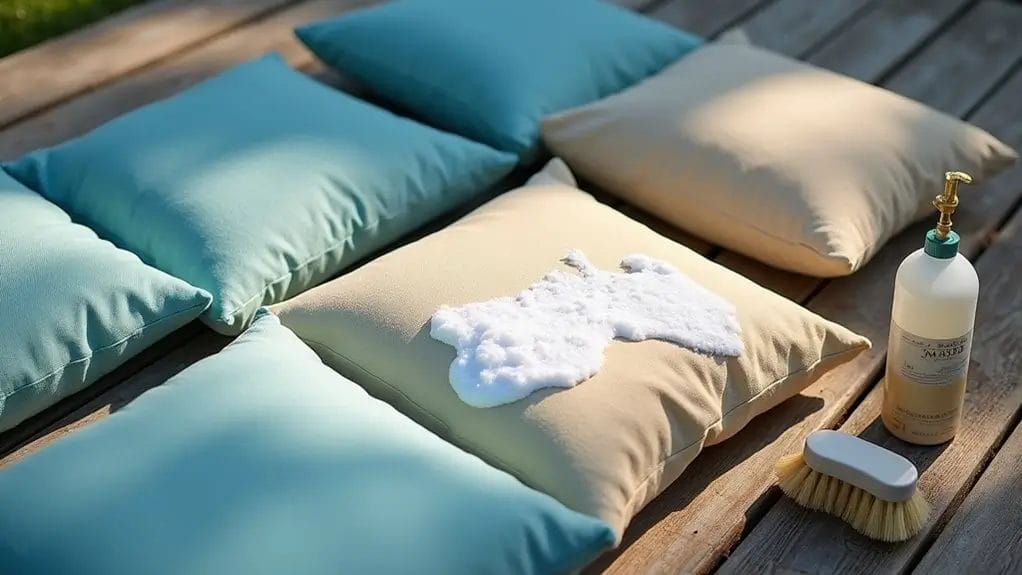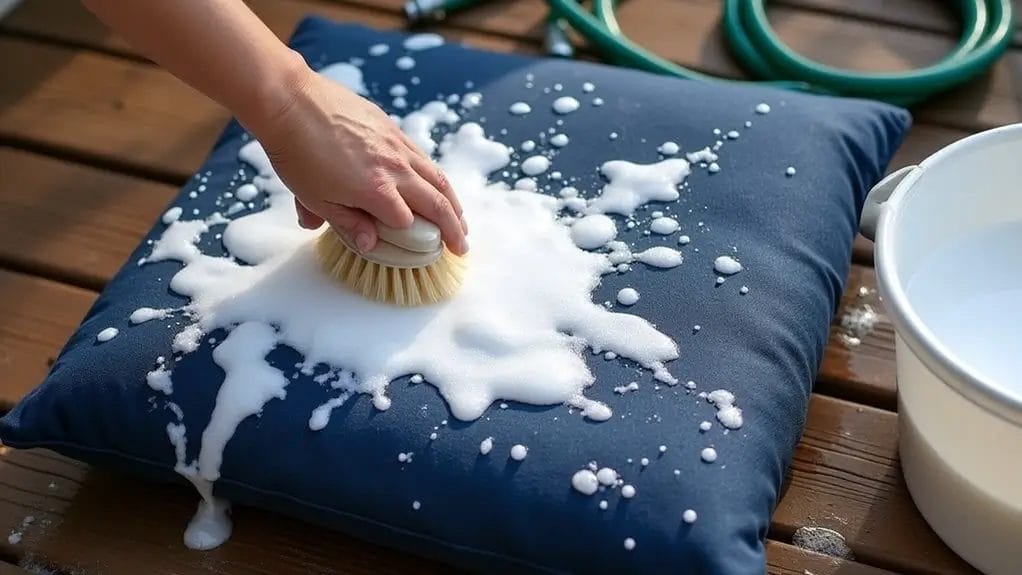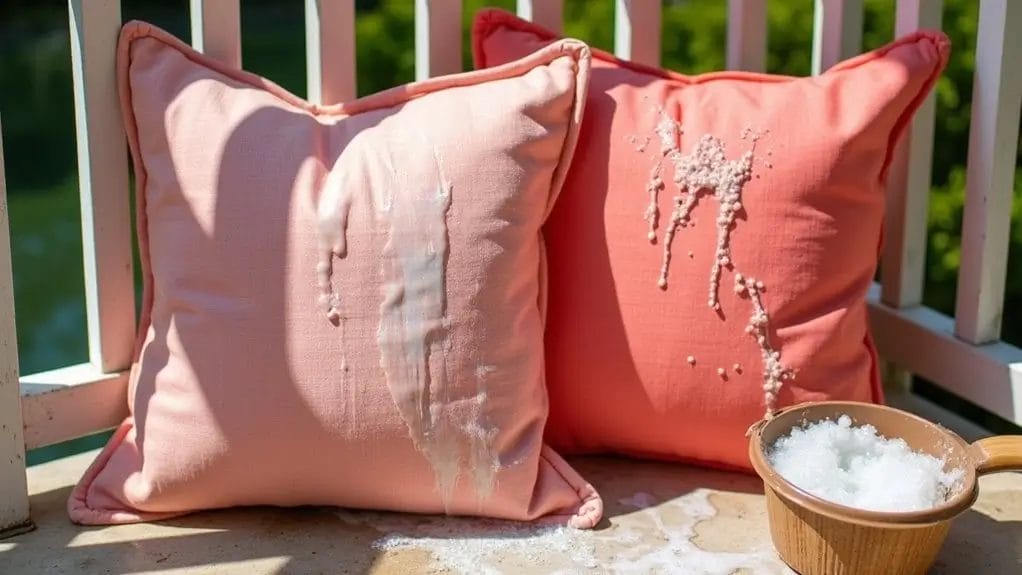Your outdoor cushions don't have to remain stained, faded, or weather-worn. With the right cleaning approach, you'll transform these essential patio pieces from grimy to pristine, extending their life and maintaining their comfort. Whether you're dealing with bird droppings, tree sap, or general dirt buildup, there's a specific method to tackle each issue. Let's explore the step-by-step process that'll help you restore your cushions to their original beauty.
Key Takeaways
- Mix 1/4 cup of detergent with one gallon of warm water for a deep-cleaning solution that restores cushions to like-new condition.
- Remove loose debris with a brush, then apply cleaning solution with gentle scrubbing motions from the outside toward the center.
- Rinse thoroughly with a garden hose until all soap residue is gone, ensuring complete removal of cleaning solutions.
- Allow cushions to air dry completely, preferably in direct sunlight, before using or storing them.
- Protect cleaned cushions with water-repellent spray and store in dry spaces with protective covers to maintain their fresh appearance.
Preparing to Clean Your Outdoor Cushions

Begin your outdoor cushion cleaning project by thoroughly inspecting each piece for specific stains, paying special attention to areas affected by food, beverages, or environmental debris.
You'll need to gather your supplies, including a cleaning detergent, a scrub brush, garden hose, and a clean working surface like a patio or grassy area.
Inspecting for Stains on Outdoor Cushions
Before diving into the cleaning process, carefully inspect your outdoor cushions for specific types of stains and soiled areas that'll require extra attention.
Look for common issues like mildew spots, food stains, bird droppings, and sun-faded patches.
Check the care instructions tag, typically found on the cushion's seam, to ascertain your planned cleaning method won't damage the fabric.
Pay special attention to creases and seams where dirt often accumulates.
Regular cleaning starts with thorough inspection - note areas that need spot treatment or extra scrubbing.
Document any severe stains that might need professional attention if your cleaning efforts don't succeed.
Gathering Necessary Supplies
Rounding up the right cleaning supplies guarantees you'll tackle your outdoor cushion cleaning project efficiently and effectively.
You'll need a bucket for your cleaning solution, a scrub brush for working on stains on cushions, and a damp cloth for initial wipe-downs.
Gather a garden hose for thorough rinsing and clean towels for drying.
To properly care for your outdoor cushions, make certain you have plastic bags or covers ready for storage.
When choosing cleaning solutions, consider your cushion fabric type and color to maintain outdoor upholstery integrity while achieving the best clean and care results.
Choosing the Right Cleaning Method
When selecting a cleaning method for your outdoor cushions, you'll need to assess both the fabric type and level of soiling to determine the most effective approach.
First, check the care label to confirm if your cushions have removable covers that are machine washable. For stubborn stains and discoloration, a detergent mixed with warm water provides excellent results. If you're dealing with light soiling, a gentle dish soap may suffice.
Spot cleaning works well for localized stains, while heavily soiled cushions require a thorough cleaning with appropriate cleaning solutions.
Remember that different fabrics may need specific treatments to maintain their integrity and appearance.
Steps to Clean Outdoor Cushions

You'll want to begin with basic hand-washing techniques using your chosen cleaning solution and a soft brush to remove everyday dirt and grime from your outdoor cushions.
For tougher cleaning jobs, you can utilize a pressure washer on its lowest setting while maintaining a safe distance of at least 2 feet from the fabric to prevent damage.
When addressing specific stains, immediately treat the affected area by blotting (never rubbing) with your cleaning solution, working from the outside of the stain toward its center to prevent spreading.
Basic Cleaning Techniques
To properly clean outdoor cushions, start by selecting a suitable cleaning area where water can drain freely, such as a patio or grassy surface.
Mix your cleaning solution using 1/4 cup of detergent with one gallon of warm water. Using a scrub brush, work the solution into your outdoor upholstery with firm, circular motions. Pay special attention to visible stains and heavy-use areas.
Thoroughly rinse the cushions with a garden hose until no soap bubbles remain. Stand them upright in a dry place to guarantee proper drainage and air dry completely.
Regular maintenance of your patio cushions will extend their life and maintain their appearance.
Using a Pressure Washer
A pressure washer can effectively deep-clean outdoor cushions, though careful attention to technique is essential for preventing damage.
When you wash your cushions with a pressure washer, start with the lowest pressure setting and keep the nozzle at least 12 inches away from the fabric. Pre-treat with a solution of warm water and detergent, then use the pressure washer to remove dirt and grime.
Give the cushions a gentle scrub between rinses if needed. Rinse thoroughly until water runs clear.
Your outdoor cushion covers will last longer when you allow them to dry completely in an upright position before use or storage.
Spot Cleaning Stains on Outdoor Cushions
Most outdoor cushion stains can be effectively treated through targeted spot cleaning, which prevents the need for deep cleaning the entire cushion.
To tackle specific stains on your outdoor upholstery, mix a solution of dish soap with warm water, or use hydrogen peroxide for tougher marks. Apply the solution directly to the stained area using a brush or sponge, working from the outside of the stain inward to prevent spreading.
Once you've treated the spot, rinse thoroughly with clean water and allow the area to dry completely. For stubborn stains, repeat the process before attempting more aggressive cleaning methods.
Maintaining Your Patio Furniture

You'll extend your outdoor cushions' lifespan by implementing a regular cleaning schedule and promptly addressing spills or stains as they occur.
To minimize dirt accumulation, consider using water-repellent sprays on your cushions and placing furniture covers over them when they're not in use.
When the off-season approaches, store your thoroughly cleaned cushions in zippered plastic bags within a dry space like a garage or shed to protect them from moisture, mildew, and pests.
Regular Cleaning Tips for Patio Furniture
Regular maintenance of patio furniture cushions keeps them looking fresh and extends their lifespan considerably. You'll need basic cleaning supplies to prevent stains from setting into your outdoor cushions.
While most patio furniture is water-resistant, it's not impervious to dirt and grime. Start with regular cleaning every few weeks during peak usage seasons.
Remove loose debris, spot clean visible stains, and perform a deep clean monthly. After cleaning, guarantee proper storage and maintenance by keeping cushions covered when not in use.
This routine will protect your investment and maintain your patio furniture's appearance throughout the seasons.
Protecting Cushions from Getting Dirty
Taking preventive measures to protect outdoor cushions from dirt and stains will greatly reduce your cleaning workload throughout the season.
To maintain your outdoor cushions, use water-resistant furniture covers whenever your seating isn't in use. Store outdoor cushions in zippered bags during extended periods of rain or harsh weather.
You'll keep your cushions looking fresh by bringing them inside each night, especially in humid climates.
For simple cleaning between deep washes, brush off debris daily and spot clean spills immediately.
Consider treating your cushions with a fabric protector spray that repels water and stains. This extra barrier helps protect your investment while extending time between thorough cleanings.
Storing Cushions During Off-Season
When cold weather approaches, proper storage of outdoor cushions becomes essential for preserving their quality and extending their lifespan.
Make certain your cushions are completely dry before storing to prevent mold and mildew growth.
Place them in custom covers or heavy-duty plastic bags, then store in a well-ventilated area like a garage, shed, or climate-controlled space.
Keep cushions elevated off the ground to protect against moisture seepage.
If you're tight on space, compress cushions in vacuum-sealed bags, but avoid long-term compression as it may damage the foam.
With proper storage techniques, you'll keep your outdoor cushions looking fresh season after season.
Frequently Asked Questions
Can Outdoor Cushions Be Cleaned With Bleach?
You shouldn't use bleach on outdoor cushions as it's too harsh and can damage fabric colors and fibers.
How Often Should Outdoor Cushions Be Professionally Cleaned?
You don't need professional cleaning annually if you maintain them regularly. However, consider professional service every 2-3 years for deep cleaning, especially if you've noticed stubborn stains or persistent odors that won't budge.
What's the Best Way to Remove Mildew Smell From Cushions?
Mix equal parts white vinegar and warm water, spray thoroughly on your cushions, scrub with a brush, and let them dry in direct sunlight.
Are Steam Cleaners Safe to Use on Outdoor Cushion Fabric?
You'll need to be cautious with steam cleaners on outdoor cushions. While they can work, you're better off using traditional cleaning methods, as excessive heat and moisture may damage fabric or encourage mold growth.
Can Outdoor Cushions Be Dried in a Clothes Dryer?
You shouldn't dry outdoor cushions in a clothes dryer, as it can damage the fabric and cause shrinkage. Instead, stand them upright in direct sunlight, allowing proper air circulation for thorough drying.
Conclusion
Regular maintenance of your outdoor cushions isn't just about aesthetics—it's essential for longevity. You'll want to stick to a consistent cleaning schedule, addressing stains promptly and performing deep cleanings at least twice per season. By following these detailed steps and using appropriate cleaning solutions, you're ensuring your cushions remain vibrant, comfortable, and protected from mold, mildew, and environmental damage.


0 comments